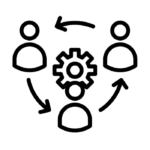The client feared losing their key engineer.
What they didn’t expect was that rotating him out would make the team stronger.

The client had recently learned that one of their key engineers, Ravi, was considering resigning. He had expressed that he was bored with the routine and wasn’t learning anything new, which led him to think that maybe it was time to move on. Naturally, this caused concern.
During a project review, the customer raised the issue, worried about the potential loss of someone so integral to the team.
Maya, understanding the risk this posed to the project’s stability, reassured them. “That’s exactly why we’ve put a rotation model in place. We don’t wait for someone to leave before planning for it.
Ravi’s knowledge and expertise won’t be lost, and we won’t let him leave just because he’s bored or not growing. Instead, we’ll rotate him to a new project, which will allow him to gain new challenges and perspectives, while ensuring continuity for the team.”
The client was still concerned. “But Ravi’s deeply embedded in this project. He knows the system inside out. We can’t just have anyone step in.”
Maya nodded and elaborated. “That’s why we build in structured shadowing and overlap. We don’t simply swap people out without a plan. We ensure a smooth transition, and the knowledge transfer happens before Ravi moves. Our Tech Leads and Architects will also stay on a bit longer to anchor the project.”
She leaned in, making sure the client understood the long-term value of the model. “In fact, we’ve implemented this rotation strategy across all projects. Every 2.5 years, engineers rotate, with proper handovers in place. This ensures that at any time, you’ll have at least three people who know the system deeply, so if someone does leave, the project keeps moving forward without disruption.”
Maya continued, “And even though Ravi is moving to a new project, he will always be reachable for assistance whenever needed. His expertise stays accessible to the team, and we’re making sure his knowledge doesn’t just walk out the door. That’s why we’ve agreed to his request for a project change, it will give him the opportunity to learn something new, but without leaving the team in the lurch.”

The client was reassured, and the plan was set in motion. Ravi was ready to transition to a new project, with a fresh set of challenges and opportunities to grow.
A few months later, Ravi was deeply involved in a completely different project—new architecture, new use cases, new technologies. His initial concerns about the transition quickly faded. He was learning again, feeling re-engaged, and enjoying the mentoring role as he helped the new engineer who had taken his place.
Maya checked in with him one afternoon.
“So, how’s the new project treating you?” she asked with a grin.
Ravi leaned back in his chair and smiled. “Honestly, it’s exactly what I needed. I was starting to feel stuck before. This move has reignited my excitement. I thought I’d miss the old project, but this feels like a fresh start. And the best part? I’ve already shared everything I know with the new guy, so I know the team’s in good hands.”
Maya grinned. “Told you. Rotation doesn’t dilute what you’ve built. It multiplies it.”
Months later, during a routine project review, the client shared their thoughts:
“Honestly, we were worried at first. Losing someone like Ravi felt like a big risk. But the way your team handled the transition with shadowing, structured overlap, and continuity from Tech Leads, was impressive. We didn’t just retain knowledge; we gained fresh energy and faster problem-solving. It’s clear now that this rotation model isn’t just a team perk. It’s a strategic advantage.”
And it showed in the numbers: the client reported a 5% reduction in project delays and noted a marked improvement in both speed and innovation. The system was more resilient, and the team more dynamic.

5%
Want to see how this approach can future-proof your team?
Reach out at info@wonderbiz.in
Key Takeaway
Attrition doesn’t shake us anymore because our rotation model quietly
protects continuity through shadowing and planned handovers.



